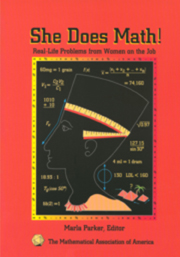Book contents
- Frontmatter
- Preface
- Contents
- Problems by Subject
- Environmental Psychology
- Software Engineering; Computer Science
- Archaeology
- Mathematics and Computer Science
- Civil Engineering
- Mathematics
- Electrical Engineering
- Physics; X-ray Astronomy Research
- Mathematics
- Physics; Astronaut Crew Training Instructor
- Business Data Processing
- Software Engineering; Real Estate Investment
- Quality Engineering
- Health Science
- Nursing Education
- Electrical Engineering; Space Systems
- Oil and Gas Accounting
- Business Administration Higher Education
- Aerospace Engineering
- Structural Engineering
- Computer Science
- Mathematics
- Dietetics—Foodservice Management and Nutrition
- Electrical Engineering
- Chemical Engineering, retired
- Software Engineering
- Immunology and Microbiology
- Mechanical Engineering
- HMO Pharmacy Practice and Management
- Ophthalmology
- Electrical Engineering
- Fish Pathology
- Computer Science and Computer Graphics
- Mathematics and Computing
- Electrical Engineering
- Astronomy
- Author
- Mathematics
- Reflections on WAM
- Solutions
Nursing Education
- Frontmatter
- Preface
- Contents
- Problems by Subject
- Environmental Psychology
- Software Engineering; Computer Science
- Archaeology
- Mathematics and Computer Science
- Civil Engineering
- Mathematics
- Electrical Engineering
- Physics; X-ray Astronomy Research
- Mathematics
- Physics; Astronaut Crew Training Instructor
- Business Data Processing
- Software Engineering; Real Estate Investment
- Quality Engineering
- Health Science
- Nursing Education
- Electrical Engineering; Space Systems
- Oil and Gas Accounting
- Business Administration Higher Education
- Aerospace Engineering
- Structural Engineering
- Computer Science
- Mathematics
- Dietetics—Foodservice Management and Nutrition
- Electrical Engineering
- Chemical Engineering, retired
- Software Engineering
- Immunology and Microbiology
- Mechanical Engineering
- HMO Pharmacy Practice and Management
- Ophthalmology
- Electrical Engineering
- Fish Pathology
- Computer Science and Computer Graphics
- Mathematics and Computing
- Electrical Engineering
- Astronomy
- Author
- Mathematics
- Reflections on WAM
- Solutions
Summary
I am currently in my sixth year of teaching in the Practical Nursing Program at the Northeast Kansas Area Vocational Technical School. One of my courses is a basic math refresher to prepare students for pharmacology classes. The majority of my students are women who, at some time in their lives, were told they didn't need to learn math. Many don't understand why nurses need to know how to use fractions and proportions. When I began my nursing career, I didn't know why, either.
In high school, I had no clear career plan in mind. I took four years of foreign language and thought I'd probably pursue that area in college. However, because I wanted a broad preparation for college, I also took three years of math: algebra, geometry, and advanced algebra, including some trigonometry. Math did not come easily to me. I spent a lot of time at the kitchen table with my father. He knew little about math himself, but using logic and experience, he usually found a solution I could understand.
My high school had no college counselor, so I chose a small women's college and enrolled in what I thought was a liberal arts track. Six weeks into classes I found that I was classified as a pre-clinic in a three-year nursing program! I decided to complete the semester so I wouldn't lose my credit hours. But as I continued, I found that I enjoyed science classes the most. And I liked the idea of helping people as a nurse.
- Type
- Chapter
- Information
- She Does Math!Real-Life Problems from Women on the Job, pp. 58 - 60Publisher: Mathematical Association of AmericaPrint publication year: 1995



